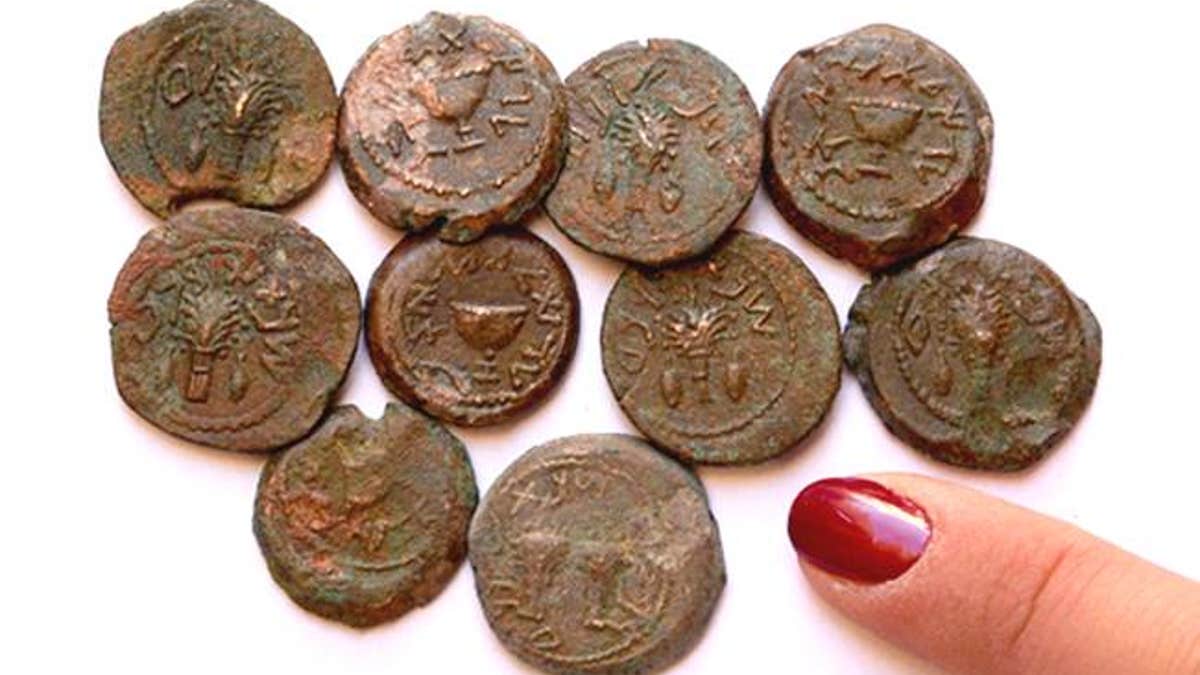
The coins are the last remnants of an ancient Jewish revolt against the Roman Empire (Eilat Mazar/ Hebrew University)
A trove of bronze coins, the last remnants of an ancient Jewish revolt against the Roman Empire, have been discovered near the Temple Mount in Jerusalem.
The coins were discovered by Hebrew University archaeologist Dr. Eilat Mazar during excavations below the Temple Mount’s southern Wall. The coins were left behind by people hiding in a large cave between 66 A.D. and 70 A.D. The tumultuous four-year period spanned the Roman siege of Jerusalem to the destruction of the Second Temple and the city.
“While several of the coins date to the early years of the revolt, the great majority are from its final year, otherwise known as, ‘Year Four’ (69-70 CE),” explained Hebrew University, in a statement. “Significantly, during the final year, the Hebrew inscription on the coins was changed from ‘For the Freedom of Zion’ to ‘For the Redemption of Zion,’ a shift which reflects the changing mood of the rebels during this period of horror and famine.”
MAJOR BIBLICAL DISCOVERY: ARCHAEOLOGISTS MAY HAVE FOUND THE PROPHET ISAIAH'S 'SIGNATURE'
The find was made shortly before the Jewish observance of Passover, which began on March 30. “A discovery like this — ancient coins bearing the words ‘Freedom’ and ‘Redemption’ — found right before the Jewish Festival of Freedom—Passover — begins is incredibly moving,” said Dr. Mazar.

The coins were discovered in ancient cave near Jerusalem's Temple Mount (Eilat Mazar/ Hebrew University)
The well-preserved coins are also decorated with Jewish symbols such as the four biblical plant species – palm, myrtle, citron and willow — as well as a picture of a goblet used in Temple services. Mazar believes that the coins are in such good condition because they were only in use for a short period of time.
Other discoveries at the site include broken pottery vessels, including jars and cooking pots, offering a fascinating glimpse into Jerusalem’s turbulent ancient history.
DRONE FINDS MYSTERIOUS ANCIENT STRUCTURE AT ISRAELI MILITARY TRAINING GROUND
The coins are the latest fascinating find in Israel. In February, for example, archaeologists announced the discovery of a clay seal mark that may bear the signature of the Biblical Prophet Isaiah.
Also in February, experts revealed that they had uncovered a rare multicolored Roman mosaic featuring three toga-wearing figures during excavations in the ancient city of Caesarea.
In January, archaeologists announced the discovery of a large 1,500-year-old pool and elaborate fountain at the site of an ancient church near Jerusalem.
ANCIENT INSCRIPTION UNEARTHED IN JERUSALEM, THRILLING ARCHAEOLOGISTS
Last November, new evidence dated Christ’s tomb in Jerusalem’s Church of the Holy Sepulchre to the Roman era, matching historical records.
Archaeologists also uncovered a stunning 1,500-year-old Christian mosaic in the ancient Mediterranean coastal city of Ashdod-Yam, now part of the modern city of Ashdod.
Other finds include the skeleton of a pregnant woman, dating back 3,200 years, in Israel’s Timna Valley, at a place once called King Solomon’s Mines.
LOST ROMAN CITY THAT WAS HOME TO JESUS' APOSTLES FOUND, SAY ARCHAEOLOGISTS
In October 2017, archaeologists in Jerusalem announced that they have uncovered a new section of the Western Wall that has been hidden for 1,700 years.
Also in 2017, an ancient Greek inscription was found on a 1,500-year-old mosaic floor near the Damascus Gate in the Old City of Jerusalem.
Some experts also believe they have found the lost Roman city of Julias, formerly the village of Bethsaida, which was the home of Jesus' apostles Peter, Andrew and Philip.
Follow James Rogers on Twitter @jamesjrogers




















